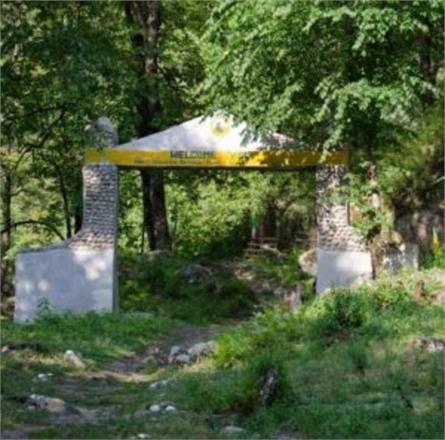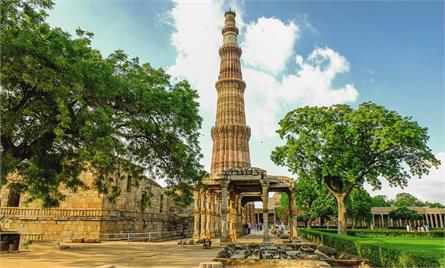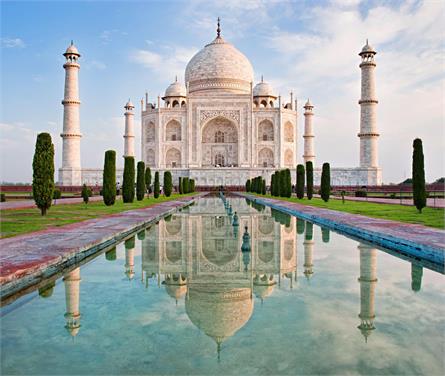Fatehpur Sikri: The Mystery & History of Mughals

Fatehpur Sikri, located in the northern Indian state of Uttar Pradesh, is a testament to the grandeur and splendor of the Mughal Empire. This historic city, founded by Emperor Akbar in the 16th century, is a remarkable blend of architectural brilliance, cultural diversity, and a rich historical legacy. Fatehpur Sikri, a jewel in the crown of India's heritage, earned its well-deserved place on the UNESCO World Heritage list in 1986. This magnificent city embodies a tapestry of history, culture, and architectural brilliance that continues to captivate the world.
Also Read: UNESCO World Heritage sites in India
Fatehpur Sikri A Mughal Masterpiece | A City of Faith and Learning | The City of Abandoned Dreams
Let's explore more detailed information about Fatehpur Sikri.
The Magnificent Mughal Legacy
Fatehpur Sikri was born from the vision of Emperor Akbar, the third ruler of the Mughal Empire, who sought to establish a new capital city that would symbolize his reign's grandeur and inclusivity. The city's construction began in 1571 and was completed in 1573. It served as the Mughal Empire's capital for approximately 14 years before being abandoned due to water scarcity issues.
Akbar's rule is often celebrated for its policy of religious tolerance and administrative reforms. Fatehpur Sikri reflects these ideals with its stunning architectural marvels, drawing inspiration from Hindu, Jain, and Persian styles. The city is a testament to Akbar's vision of unity in diversity and cultural assimilation.
Also Read: Chhatrapati Shivaji Terminus A Glimpse into Mumbai's Architectural and Historical Marvel
Architectural Splendors
Fatehpur Sikri boasts a collection of awe-inspiring architectural wonders that have stood the test of time. The Buland Darwaza, or the "Gate of Magnificence," is a towering masterpiece among these. This grand entranceway is an imposing structure with intricate carvings and inscriptions, welcoming visitors with its grandeur.
The Jama Masjid, one of India's largest mosques, is another architectural gem within the city. Its vast courtyard and striking red sandstone construction are truly remarkable. The central mihrab (prayer niche) showcases the Mughal love for intricate detailing and calligraphy.
The Panch Mahal, a five-story palace with diminishing tiers, is an elegant structure that served as a place of relaxation and entertainment for the emperor and his court. Its open pavilions provided respite from the scorching Indian summers.
Diwan-i-Khas, or the Hall of Private Audience, is a delicately designed structure where Akbar met with his closest advisors. Its central pillar, adorned with carved elephant brackets, adds to its regal aura.
Also Read: National Parks of India
Architectural Details
Fatehpur Sikri's architecture is marked by the extensive use of red sandstone, which gives the structures their distinctive reddish hue. The carvings on the walls and facades are incredibly detailed and feature motifs from various religious traditions, showcasing the eclecticism of Mughal art.
Inside the structures, you can find exquisite examples of Mughal tile work, intricate geometric patterns, and inscriptions from the Quran. The architectural layout is meticulously planned, with gardens, water channels, and fountains contributing to the city's aesthetic appeal.
Also Read: Agra Fort, India's Majestic Jewel of Mughal Architecture
Intriguing Mysteries
One of the enduring mysteries of Fatehpur Sikri is the reason behind its abandonment. Despite being a thriving capital for a short period, the city was deserted due to an acute shortage of water. Theories abound, but the exact cause remains a subject of debate among historians.
The city also houses the tomb of Salim Chishti, a revered Sufi saint, whose blessings were sought by Akbar for an heir to the throne. Miraculously, Akbar's wish was granted, and he named his son Salim in the saint's honor. Pilgrims from across the world visit this shrine to seek blessings and witness the unique white marble structure.
Also Read: The Enigmatic Ajanta Caves
Cultural Significance
Fatehpur Sikri is not just an architectural marvel but also a cultural hotspot. The city's rich history has left an indelible mark on Indian culture and heritage. Its blend of Hindu, Jain, and Persian architectural styles showcases the syncretic nature of Mughal India.
The city also holds a special place in the hearts of literature and art enthusiasts. Many poets, musicians, and artists were patronized by Akbar during his time in Fatehpur Sikri. The result was a flourishing of artistic endeavors that continue to influence Indian culture.
Also Read: The Ancient Ruins of Dholavira & Harappan Civilization
Visiting Fatehpur Sikri Today
Fatehpur Sikri, located just 40 kilometers from Agra, the city famous for the Taj Mahal, is easily accessible by road. It attracts tourists from all corners of the globe who come to marvel at its architectural splendors and delve into its rich history.
The site is well-preserved, and visitors can explore the various structures, each with its unique story to tell. A guided tour is recommended to fully appreciate the historical significance of the place.
Also Read: Champaner-Pavagadh, A Must-Visit Site For History And Architecture Lovers
Historical Significance
Fatehpur Sikri played a pivotal role in the history of the Mughal Empire. It was not only a symbol of Akbar's architectural ambitions but also a center of political power. The city witnessed important events and decisions that shaped the course of the empire. It was in Fatehpur Sikri that Akbar held discussions with scholars and religious leaders from various faiths, leading to the creation of his unique religious philosophy, Din-i Ilahi, which sought to unify different religions.
Akbar's Palace Complex
Fatehpur Sikri houses a sprawling palace complex that includes several fascinating structures. The Jodha Bai Palace, named after Akbar's Rajput queen, is a magnificent blend of Rajput and Mughal architectural styles. It features spacious courtyards, ornate balconies, and intricate latticework.
The Birbal Bhavan, named after Akbar's trusted advisor Birbal, is another prominent structure within the palace complex. It is believed to be the residence of Birbal and showcases the fusion of Persian and Indian architectural elements.
Also Read: The Beauty of Buddhist Monuments Heritage At Sanchi
Fatehpur Sikri's Role as a Cultural Hub
Beyond its political significance, Fatehpur Sikri was a thriving cultural center. The city was home to a vibrant community of artists, musicians, poets, and scholars who received patronage from Akbar's court. This led to the development of a unique Mughal culture that blended various artistic and intellectual traditions.
Notable figures like the musician Tansen and the poet Faizi were part of the court at Fatehpur Sikri. Their contributions to Indian classical music and poetry continue to be celebrated today.
Also Read: Nalanda Mahavihara: The Ancient Seat of Learning in Bihar
Religious Sites
Fatehpur Sikri is not just about imperial grandeur; it also houses significant religious sites. Apart from the Jama Masjid and the shrine of Salim Chishti, there's the stunning Sunehri Masjid, or "Golden Mosque," with its gilded ornamentation. The Naubat Khana, or Drum House, served as a place for musicians to announce the emperor's arrival and is also a site of historical and architectural interest.
Fatehpur Sikri's Revival
In recent years, efforts have been made to restore and preserve the historical structures at Fatehpur Sikri. Conservation projects, including structural repairs and the cleaning of delicate carvings, have been undertaken to ensure the site's continued cultural significance and its attraction as a tourist destination.
Also Read: Churches and Convents of Goa The UNESCO Heritage
Fatehpur Sikri is a remarkable historical and architectural gem that offers visitors a glimpse into the grandeur and cultural richness of the Mughal era. Its intricate architecture, historical importance, and cultural contributions make it a must-visit destination for anyone interested in India's vibrant past. While the water scarcity theory remains the most widely accepted explanation, the mystery of Fatehpur Sikri's abandonment continues to spark scholarly debate and research. It adds an aura of intrigue to an already fascinating historical site, leaving visitors and historians alike with questions about the rise and fall of this magnificent Mughal capital.














